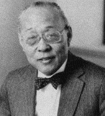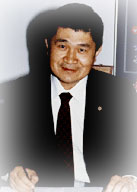|
GOLDSEA |
ASIAMS.NET |
ASIAN AMERICAN PERSONALITIES
PIONEERS OF
THE DIGITAL REVO LUTION
 he thread connecting these pioneers of the digital revolution isn't big tech-boom bucks. Only half pocketed multi-millions from their pioneering work. Two were forced out of their businesses. Two of their businesses ended up in bankruptcy. One committed suicide or, some suspect, was murdered.
he thread connecting these pioneers of the digital revolution isn't big tech-boom bucks. Only half pocketed multi-millions from their pioneering work. Two were forced out of their businesses. Two of their businesses ended up in bankruptcy. One committed suicide or, some suspect, was murdered.
The only thing all share in common is a steadfastly shining vision of the boundless possibilities that digital automation offers for improving human life. To be sure, they played up the profit potential as the mechanism for nurturing and sustaining ambitious new technologies. But what fired up the world was their passion for cool new ways to use bits of code and chips of silicon to make life more productive, less tedious and, ultimately, richer.
We recognize these pioneers for not only their exceptional intellects and fairy-tale breaks, but for their blue-sky faith in the infinite upgradeability of human life.

1. An Wang
Inventor of Magnetic-Core Memory; Founder of Wang Laboratories
 ay back in 1948 a young Harvard researcher named An Wang planted the seeds for computing technology by showing that data could be stored in an array of magnetic ferrite cores. Harvard didn't bother patenting the discovery. Wang personally filed the patent application in September of 1949 without suspecting the seminal role his invention would come to play in the computer revolution.
ay back in 1948 a young Harvard researcher named An Wang planted the seeds for computing technology by showing that data could be stored in an array of magnetic ferrite cores. Harvard didn't bother patenting the discovery. Wang personally filed the patent application in September of 1949 without suspecting the seminal role his invention would come to play in the computer revolution.
On June 22, 1951 Wang began tapping the new technology's potential by founding Wang Laboratories in Boston with $600 in savings. “I founded Wang Laboratories to show that Chinese could excel at things other than running laundries and restaurants,” Wang once said. The money IBM paid in 1955 for Wang's magnetic-core memory patent provided some of the capital for his venture.
The company's early success helped a clumsy new technology evolve into useful calculating machines and word processors, creating impetus for the personal computing revolution. Wang later turned over control of a struggling Wang Labs to his son, and the company ultimately ended up in bankruptcy. That doesn't diminish An Wang's position as the grandaddy of Asian American digital pioneers.
An Wang was born February 2, 1920 in China and immigrated to the U.S. in 1945. He died in 1990.
CONTINUED BELOW
 2. David S. Lee
2. David S. Lee
Inventor of Daisywheel Printer; First Asian in Executive Suite of Top 10 U.S. Corporation
 ne of the first popular uses of the so-called mini-computers of the 1970s was word-processing. That created a demand for faster printers. In 1969 David S. Lee and his small engineering team at Diablo Systems developed the first efficient daisywheel printer. It represented a quantum speed leap over existing printers which were still using typewriter mechanisms.
ne of the first popular uses of the so-called mini-computers of the 1970s was word-processing. That created a demand for faster printers. In 1969 David S. Lee and his small engineering team at Diablo Systems developed the first efficient daisywheel printer. It represented a quantum speed leap over existing printers which were still using typewriter mechanisms.
When Diablo Systems was sold to Xerox in 1972, Lee was replaced as head of the printer group by a less capable engineer. Unhappy with such blatant racial bias, Lee left a year later to co-found Qume. Under Lee's technical leadership Qume established itself as the industry leader. When Lee and partners sold it in 1978 for $165 million, investors earned a 93-fold return on their original investments. Qume owns the distinction of being the first Silicon Valley company to be sold for over $100 million. Ê
In 1981 Lee became the first Asian American to enter the corporate suite of one of America's top-5 corporations when he was named president of ITT Qume and chairman of ITT's business information systems group. After ITT sold its computing division to Alcatel in 1978, Lee left to start a series of tech companies.
David Lee was born in Beijing. His family moved to Hong Kong and Taiwan before settling in Argentina. He came to the U.S. on a student visa to study mechanical engineering at Montana State University. He got his masters at North Dakota State and PhD at Ohio State University. His pioneering success combined with a genial personality and big rubber smile made Lee a leading light in the Silicon Valley Asian community. Since the 1990s he has been influential in Republican presidential politics. He was named to the board of the regent of the University of California in 1995.
PAGE 2
1 |
2 |
3
|
|
|
|

|
“Unhappy with such blatant racial bias, Lee left a year later to co-found Qume. ”
|
CONTACT US
|
ADVERTISING INFO
© 1996-2013 Asian Media Group Inc
No part of the contents of this site may be reproduced without prior written permission.
|


 he thread connecting these pioneers of the digital revolution isn't big tech-boom bucks. Only half pocketed multi-millions from their pioneering work. Two were forced out of their businesses. Two of their businesses ended up in bankruptcy. One committed suicide or, some suspect, was murdered.
he thread connecting these pioneers of the digital revolution isn't big tech-boom bucks. Only half pocketed multi-millions from their pioneering work. Two were forced out of their businesses. Two of their businesses ended up in bankruptcy. One committed suicide or, some suspect, was murdered.
 ay back in 1948 a young Harvard researcher named An Wang planted the seeds for computing technology by showing that data could be stored in an array of magnetic ferrite cores. Harvard didn't bother patenting the discovery. Wang personally filed the patent application in September of 1949 without suspecting the seminal role his invention would come to play in the computer revolution.
ay back in 1948 a young Harvard researcher named An Wang planted the seeds for computing technology by showing that data could be stored in an array of magnetic ferrite cores. Harvard didn't bother patenting the discovery. Wang personally filed the patent application in September of 1949 without suspecting the seminal role his invention would come to play in the computer revolution.

 ne of the first popular uses of the so-called mini-computers of the 1970s was word-processing. That created a demand for faster printers. In 1969 David S. Lee and his small engineering team at Diablo Systems developed the first efficient daisywheel printer. It represented a quantum speed leap over existing printers which were still using typewriter mechanisms.
ne of the first popular uses of the so-called mini-computers of the 1970s was word-processing. That created a demand for faster printers. In 1969 David S. Lee and his small engineering team at Diablo Systems developed the first efficient daisywheel printer. It represented a quantum speed leap over existing printers which were still using typewriter mechanisms.
